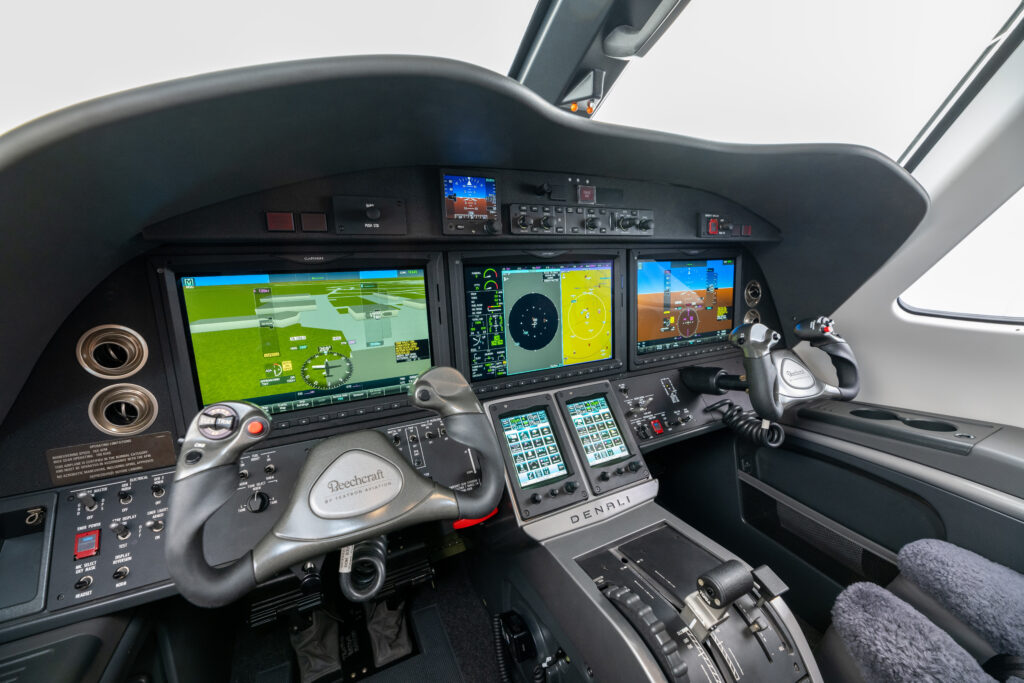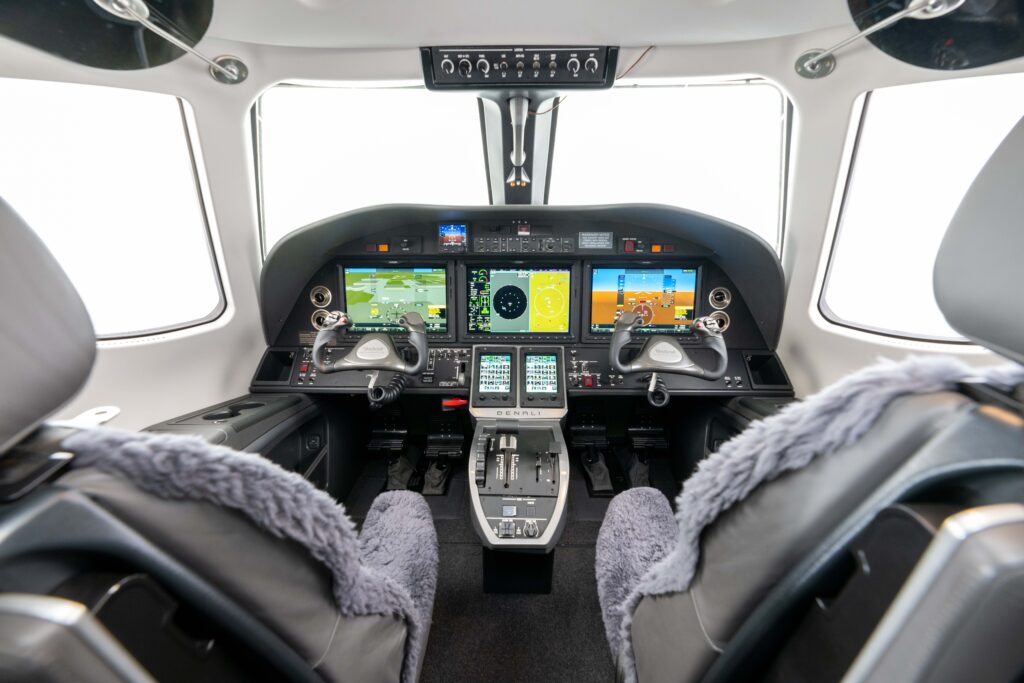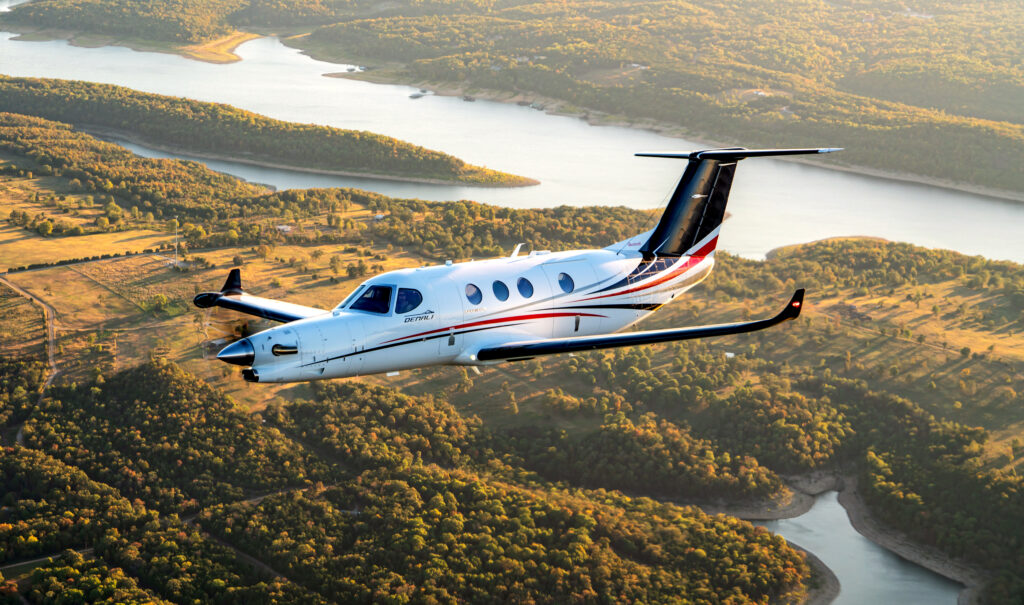Why this aircraft matters
The Beechcraft Denali turboprop is Textron Aviation’s clean-sheet answer to the single-engine utility/luxury market—built around the GE Aerospace Catalyst engine and a Garmin G3000 flight deck with integrated autothrottle and Emergency Autoland standard. Translation: jet-like power management, best-in-class cockpit automation, and a cabin that flexes between six-seat executive comfort and nine-seat corporate shuttle.
Key Talking Points (fast)
- Autoland as standard: press a button; the airplane lands itself—immense peace-of-mind for owners and charter ops.
- Catalyst engine: full-authority dual-channel FADEC, single-lever control, advanced manufacturing (incl. additive), and certified by the FAA in 2025.
- Mission profile: 285 ktas cruise, 1,600 nm range (4-pax), 2,900 ft takeoff—short-field capable and continent-hopping ready.
- Status: program advancing; aircraft certification currently targeted for 2026.
Cabin: executive comfort or nine-seat productivity
Denali’s jet-inspired cabin is configurable:
- Executive (6) with a refreshment center for owner-operators and VIP shuttle.
- Commuter (up to 9) for corporate or fractional/charter uplift.
Large windows, a generous cross-section, USB power throughout, and an optional removable aft lavatory add real-world flexibility without compromising the cabin.
Avionics & safety: the “calm cockpit” advantage

The flight deck pairs Garmin G3000 (three 14″ displays, two touch controllers, SVT) with integrated autothrottle and single-lever power via FADEC.
The safety stack—Emergency Autoland, TAWS-B, TCAS I, radar, dual AHRS/ADC—pushes single-pilot workload down and situational awareness up.
For family ops and charter alike, Autoland is the ultimate guardian feature.
Powerplant: GE Aerospace Catalyst (1,300 shp)
Catalyst brings a modern turbine architecture to the class: dual-channel FADEC, optimized fuel scheduling, extensive 3D-printed components, and commercial-engine pedigree.
The result is jet-like throttle response with strong efficiency, supporting performance numbers that matter to owners (fewer stops, simpler engine management, better dispatch).
FAA certification was achieved on Feb 27, 2025—a significant milestone, clearing the path for Denali’s type certification.

Exact Specifications (official)
Dimensions
- Length: 48 ft 9 in (14.9 m)
- Height: 15 ft 2 in (4.6 m)
- Wingspan: 54 ft 3 in (16.54 m)
- Wing Area: 286 sq ft (26.55 sq m)
- Wheelbase: 15 ft 1 in (4.60 m)
- Tread: 16 ft 6 in (5.03 m)
Cabin Interior
- Height: 58 in (1.5 m)
- Width: 63 in (1.60 m)
- Length: 16 ft 9 in (5.1 m)
- Maximum occupants: 11
- Baggage volume: 78 cu ft (2.21 cu m)
Performance
- Maximum cruise speed: 285 ktas (528 km/h)
- 4-passenger range: 1,600 nm (2,963 km)
- Takeoff distance: 2,900 ft (884 m)
- Maximum operating altitude: 31,000 ft (9,449 m)
Powerplant
- Manufacturer: GE Aerospace
- Model: Catalyst 1300-CS1A
- Power rating: 1,300 shp (969 kW)
- Propeller: McCauley, 5-blade composite, constant-speed, fully reversing

All specs above are taken verbatim from Textron Aviation’s official Denali page and documentation.
Use-cases that win
- Owner-operators upgrading from high-performance pistons or light turboprops want Autoland and a bigger cabin without the complexity of twins.
- Charter & fractional, where cabin experience and safety tech influence booking decisions; a nine-seat shuttle is a revenue unlock.
- Corporate flight departments need a short-runway, low-DOCs solution with modern avionics parity across fleets.

Market context (who it’s built to challenge)
The Denali enters a segment anchored by the Pilatus PC-12 and touches the TBM/Epic buyer envelope—competing on cabin volume, automation, and ownership simplicity via FADEC + Autoland.
Buying intelligence (practical)
- Timeline: plan for 2026 aircraft certification/entry based on most recent program signals; engine is already FAA-certified.
- Pilot transition: G3000 + Autoland + autothrottle minimize training friction if you’re already in Garmin glass.
- Charter ops: the cabin configurability, baggage volume, and safety stack are revenue-friendly differentiators in single-engine categories.
Bottom line

If you want a forward-leaning single-engine workhorse with a luxury-grade cabin, the Beechcraft Denali turboprop is the most modern spec sheet in the class—Autoland included. For owner-operators and charter programs, that’s a tangible step-change in safety, usability, and brand equity. Watch the 2026 certification horizon; if it holds, this airplane will land—and arrive in style.
Beechcraft Denali turboprop — FAQs
Is Garmin® Emergency Autoland standard on the Beechcraft Denali turboprop?
Yes. Garmin Emergency Autoland is listed as a standard safety feature alongside the Garmin G3000 flight deck and integrated autothrottle.
When is certification and entry into service expected?
Textron Aviation is targeting 2026 for the Denali’s type certification. The GE Aerospace Catalyst engine received FAA certification on February 27, 2025, clearing a major milestone.
What are the exact performance specs of the Beechcraft Denali turboprop?
- Maximum cruise speed: 285 ktas (528 km/h)
- Range (4 pax): 1,600 nm (2,963 km)
- Takeoff distance: 2,900 ft (884 m)
- Maximum operating altitude: 31,000 ft (9,449 m)
How many seats and layouts are available?
The cabin supports up to 11 occupants and can be configured as a six-seat executive layout with refreshment center or a nine-seat commuter layout.
Which engine and propeller does the Denali use?
A GE Aerospace Catalyst 1300-CS1A rated at 1,300 shp (969 kW) with dual-channel FADEC, paired with a McCauley 5-blade composite, constant-speed, fully reversing propeller.
What are the interior dimensions and baggage volume?
- Cabin height: 58 in (1.5 m)
- Cabin width: 63 in (1.60 m)
- Cabin length: 16 ft 9 in (5.1 m)
- Baggage volume: 78 cu ft (2.21 cu m)
What avionics come standard on the Beechcraft Denali turboprop?
Garmin G3000 with three 14" widescreen displays, two touch controllers, integrated autothrottle, Synthetic Vision Technology, Emergency Autoland, dual FMS with WAAS GPS, TAWS-B, TCAS I, weather radar, dual AHRS/ADC, and a digital audio system.













